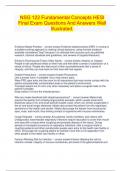NSG 122 Fundamental Concepts HESI
Final Exam Questions And Answers Well
Illustrated.
Evidence Based Practice - correct answer.Evidence-based practice (EBP) in nursing is
a problem-solving approach to making clinical decisions, using the best evidence
available (considered "best" because it is collected from sources such as published
research, national standards and guidelines, and reviews of targeted literature).
Erikson's Psychosocial Theory Older Adults - correct answer.Integrity vs. Despair
People in late adulthood reflect on their lives and feel either a sense of satisfaction or a
sense of failure. People who feel proud of their accomplishments feel a sense of
integrity, and they can look back on their lives with few regrets.
Droplet Precautions - correct answer.Droplet Precautions:
Use a private room, if available. Door may remain open.
Wear PPE upon entry into the room for all interactions that may involve contact with the
patient and potentially contaminated areas in the patient's environment.
Transport patient out of room only when necessary and place a surgical mask on the
patient if possible.
Keep visitors 3 ft from the infected person.
Why are masks beneficial with droplet precautions? - correct answer.Masks help
prevent the wearer from inhaling large-particle aerosols, which usually travel short
distances (about 3 ft), and small-particle droplet nuclei, which can remain suspended in
the air and travel longer distances. Masks also protect the patient from the respiratory
secretions of the health care worker. Masks discourage the wearer from touching the
eyes, nose, and mouth, thus limiting contact of organisms with mucous membranes.
Cough Etiquette - correct answer.Any patients, family members, and visitors with
undiagnosed, transmissible respiratory infections require education to cover their mouth
and nose with a tissue when coughing and promptly dispose of the tissue. During
periods of increased occurrence of respiratory infections, offer a surgical mask to
coughing patients and other symptomatic people upon entry to the health care facility or
office. Encourage the coughing patient to maintain more than a 3-ft separation from
other people in the health care facility or office.
Factors Affecting Risk for Infection - correct answer.Factors affecting the risk for
infection include: integrity of mucous membranes, pH levels of the gastrointestinal and
, genitourinary tracts, immune response, age, sex, race, heredity, level of fatigue,
nutritional status, stress level, use of invasive or indwelling medical devices and
immunizations (natural or acquired)
Abnormal Wound Drainage - correct answer.Purulent drainage is made up of white
blood cells, liquefied dead tissue debris, and both dead and live bacteria. Purulent
drainage is thick, often has a musty or foul odor, and varies in color (such as dark
yellow or green), depending on the causative organism.
Pressure Ulcer Stage 1 - correct answer.A stage 1 pressure injury is a defined,
localized area of intact skin with nonblanchable erythema (redness). Darkly pigmented
skin may not have visible blanching; its color may differ from the surrounding skin. The
area may be painful, firm, soft, warmer, or cooler as compared to adjacent tissue
Pressure Ulcer Stage 2 - correct answer.A stage 2 pressure injury involves partial-
thickness loss of dermis and presents as a shallow, open ulcer or a ruptured/intact
serum-filled blister
Pressure Ulcer Stage 3 - correct answer.A stage 3 pressure injury presents with full-
thickness tissue loss. Subcutaneous fat may be visible and epibole (rolled wound
edges) may occur, but bone, tendon, or muscle is not exposed. Slough and/or eschar
that may be present do not obscure the depth of tissue loss. Ulcers
Pressure Ulcer Stage 4 - correct answer.Stage 4 injuries involve full-thickness tissue
loss with exposed or palpable bone, cartilage, ligament, tendon, fascia, or muscle.
Slough or eschar may be present on some part of the wound bed; epibole, undermining,
and/or tunneling often occur
Wound Infection - correct answer.Symptoms of infection include purulent drainage;
increased drainage, pain, redness, and swelling in and around the wound; increased
body temperature; and increased white blood cell count. Additional signs and symptoms
include delayed healing and discoloration of granulation tissue in the wound
Braden Scale - correct answer.Braden Scale: mental status, continence, mobility,
activity, and nutrition
Using the Braden scale, a score of 19 to 23 indicates no risk; 15 to 18, mild risk; 13 to
14, moderate risk; 10 to 12, high risk; and 9 or lower, very high risk
Heat Application - correct answer.The application of heat accelerates the inflammatory
response to promote healing.
The application of local heat dilates peripheral blood vessels, increases tissue
metabolism, reduces blood viscosity and increases capillary permeability, reduces
muscle tension, and helps relieve pain. Vasodilation increases local blood flow. In turn,
the supply of oxygen and nutrients to the area is increased, and venous congestion is
decreased
Careful on large parts of the body




